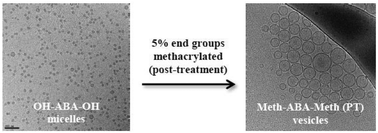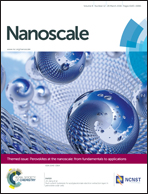Terminal groups control self-assembly of amphiphilic block copolymers in solution†
Abstract
The terminal groups of amphiphilic block copolymers are shown to control macromolecular self-assembly in aqueous solutions, in the micellar/lamellar region of the phase diagram. At the same concentration and using the same self-assembly conditions, dramatic differences are observed in polymer hydration and the resulting nano-/microstructure for two series of polymers with identical block chemistry and hydrophilic–lipophilic balance (HLB). This suggests a strong contribution from end groups to the hydration as the initial step of the self-assembly process, and could be conveniently used to guide the particle morphology and size. Additionally, for polymers with those head groups which drive vesicular structures, differences in membrane organization affect their physical properties, such as permeability.


 Please wait while we load your content...
Please wait while we load your content...